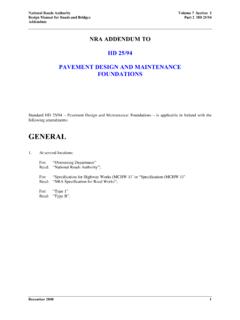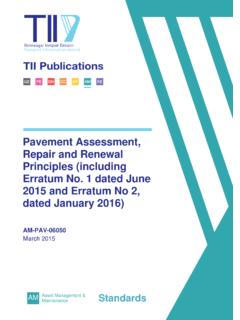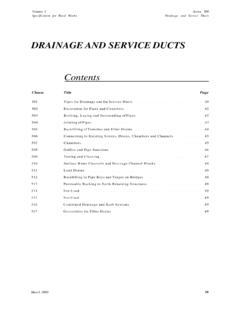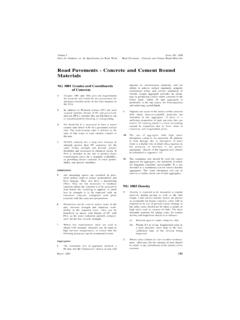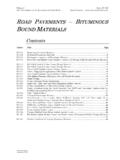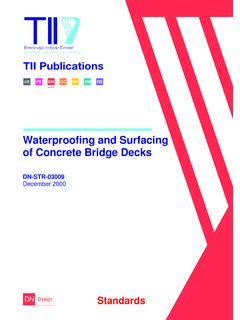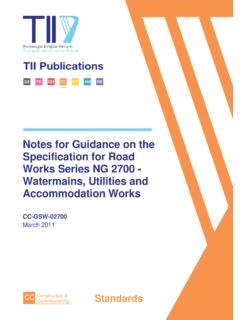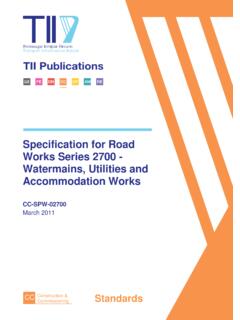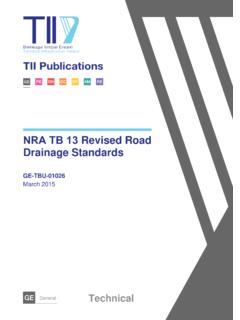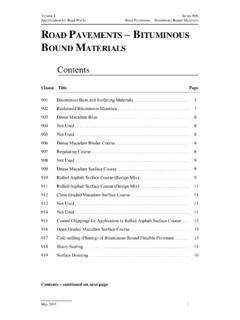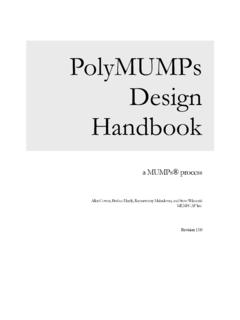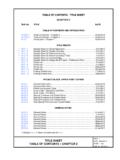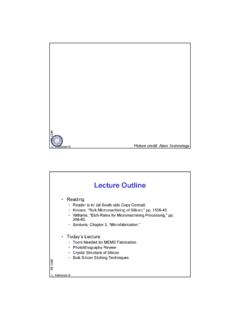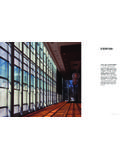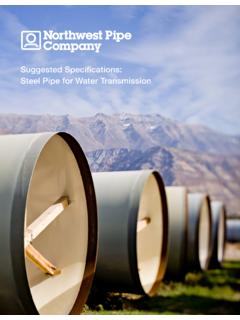Transcription of Portal and Cantilever Sign/Signal Gantries - TII …
1 Portal and Cantilever Sign/Signal Gantries DN-STR-03010. December 2014. DN Design Standards TRANSPORT INFRASTRUCTURE IRELAND (TII) PUBLICATIONS. About TII. Transport Infrastructure Ireland (TII) is responsible for managing and improving the country's national road and light rail networks. About TII Publications TII maintains an online suite of technical publications, which is managed through the TII. Publications website. The contents of TII Publications is clearly split into Standards' and Technical' documentation. All documentation for implementation on TII schemes is collectively referred to as TII Publications (Standards), and all other documentation within the system is collectively referred to as TII Publications (Technical). This system replaces the NRA Design Manual for Roads and Bridges (NRA DMRB) and the NRA Manual of Contract Documents for Road Works (NRA MCDRW).
2 Document Attributes Each document within TII Publications has a range of attributes associated with it, which allows for efficient access and retrieval of the document from the website. These attributes are also contained on the inside cover of each current document, for reference. For migration of documents from the NRA and RPA to the new system, each current document was assigned with new outer front and rear covers. Apart from the covers, and inside cover pages, the documents contain the same information as previously within the NRA or RPA systems, including historical references such as those contained within NRA DMRB and NRA MCDRW. Document Attributes TII Publication Title Portal and Cantilever Sign/Signal Gantries TII Publication DN-STR-03010. Number Activity Design (DN) Document Set Standards Stream Structures (STR) Publication Date December 2014. Document 03010 Historical NRA BD 51.
3 Number Reference NRA DMRB and MCDRW References For all documents that existed within the NRA DMRB or the NRA MCDRW prior to the launch of TII Publications, the NRA document reference used previously is listed above under historical reference'. The TII Publication Number also shown above now supersedes this historical reference. All historical references within this document are deemed to be replaced by the TII. Publication Number. For the equivalent TII Publication Number for all other historical references contained within this document, please refer to the TII Publications website. Volume 2 Section 2. Part 4. NRA BD 51/14. Portal and Cantilever Sign/Signal Gantries December 2014. St. Martin's House, Waterloo Road, Dublin 4 Tel: +353 1 660 2511 Fax +353 1 668 0009. Email: Web: Summary: This standard sets out the design criteria and considerations for Portal and Cantilever sign / signal Gantries for use over national roads.
4 It updates and replaces the NRA Addendum to BD 51/98. Published by National Roads Authority, Dublin 2014. NRA DESIGN MANUAL FOR ROADS AND BRIDGES. VOLUME 2 ROADS STRUCTURES: DESIGN (SUBSTRUCTURES. AND SPECIAL. STRUCTURES), MATERIALS. SECTION 2 SPECIAL STRUCTURES. PART 4. NRA BD 51/14. Portal AND Cantilever Sign/Signal . Gantries . Contents Chapter 1. Introduction 2. General Design Principles 3. Limit State Design 4. Actions 5. General Design Requirement 6. References 7. Enquiries APPENDIX A: NRA Gantry Figures APPENDIX B: Typical Equipment APPENDIX C: Appearance APPENDIX D: Dynamic Analysis for a Dynamically Sensitive Gantry APPENDIX E: Design of Gantries with Permanent Maintenance Access APPENDIX F: Table of Gantry Features December 2014 i National Roads Authority Volume 2 Section 2. Design Manual for Roads and Bridges Part 4 NRA BD 51/14. 1. INTRODUCTION. Background This Standard supersedes the NRA Addendum to BD51/98.
5 The main changes are: a) Compliance with Eurocodes and removal of references to superseded structural design standards;. b) Restriction of scope to structural design only scheme design is not covered in this Standard;. c) Removal of detailed itemisation of gantry equipment provision. Scope This Standard covers the design of Portal and Cantilever sign and signal Gantries (see Appendix A. Figures) and sets out their structural design requirements in accordance with the National Roads Authority's requirements for the use of Eurocodes. It is intended for use in designing permanent and temporary structures which wholly span or are partially cantilevered over the carriageway, hard shoulder and/or hard strip for the purpose of supporting large signs and/ or motorway type signals and/or message signs, such as, but not exclusively, the examples shown in Appendix A, but excluding Cantilever or other traffic signal masts which are covered in NRA BD 94 Design of Minor Structures.
6 This Standard specifies criteria and advice for the structural design of sign and signal Gantries of Portal and Cantilever types for use on national roads including motorways, where any part of the sign or motorway signal and their supporting structure is mounted over the carriageway, central reserve, hard shoulder and/or hard strip. The selection of suitable sign and signal configurations is outside the scope of this standard. Refer to the NRA MCDRW Series 1800 Volume 4, Road Construction Details, for further information pertaining to the structural form of permissible sign supports. Scheme design is not covered by this document. It is assumed that the gantry positions are determined as part of the scheme design. This Standard only considers the position of the gantry where it has a direct implication on the structural design. Definitions and Abbreviations Specific definitions applicable for this Standard are given below: a) Carriageway For the purposes of this Standard, the carriageway width is taken to be the traffic running surface which includes all traffic lanes, hard shoulders, hard strips and marker strips, between raised kerbs.
7 In the absence of raised kerbs, it is the width between safety fences, less the amount of set-back. The carriageway width should be measured in a direction at right angles to the line of the raised kerbs, lane marks or edge marking. b) Eurocodes For the purpose of this Standard, Eurocodes shall be taken to include the Irish National Annexes and relevant requirements of associated Published Documents as specified by the NRA. December 2014 1. National Roads Authority Volume 2 Section 2. Design Manual for Roads and Bridges Part 4 NRA BD 51/14. c) Gantry Generic term for structure supporting signs, signals, Variable Message Signs (VMS) and other equipment. Gantry includes single or multiple portals, single and double cantilevers and combinations of same. d) ITS Gantry ITS Gantries are those that are designed specifically for use with ITS equipment. Refer to NRA MCDRW Series 1800 Volume 4, Road Construction Details for further information.
8 E) Outreach of Cantilever Length of Cantilever from traffic face of support to tip. f) Published Documents For the purpose of this Standard, Published Documents contain non-contradictory complementary information (NCCI) to assist in the application of Eurocode Principles. g) sign A device carrying directional or other informational message, route information at the approach to a junction. h) signal A device which uses lights to give advisory or mandatory instructions, stop, or 50 kph speed restriction. i) Standard Gantry Typical gantry structure that has been designed for possible re-use without modification across the network. Refer to NRA MCDRW Series 1800 Volume 4, Road Construction Details for further information. j) Supports Vertical structural member supporting horizontal member, sign , signal and/or associated equipment. k) Variable Message sign (VMS). sign capable of displaying a variety of text, messages and/or symbols.
9 L) Vehicle Restraint System (VRS). Installation to provide a level of containment for errant vehicles in order to limit damage or injury to road users. All Gantries within of the carriageway must be designed for the vehicle collision loading given in Table regardless of the presence of a Vehicle Restraint System. References in this Standard to IS EN documents include their Irish National Annexes. December 2014 2. National Roads Authority Volume 2 Section 2. Design Manual for Roads and Bridges Part 4 NRA BD 51/14. 2. GENERAL DESIGN PRINCIPLES. Siting Once the need for a gantry has been established, the siting of structures shall be in accordance with NRA TD 9. Design Procedures The design criteria are set out in sections 3 and 4 with the design working life given in clause Technical Acceptance Technical Acceptance of the designs for construction, alteration and re-positioning of Sign/Signal Portal and Cantilever Gantries must comply with the requirements of NRA BD 02 and must be obtained from the structures section of the NRA prior to any construction.
10 Design Working Life The required design working life for Gantries is 60 years. In the design for wind and thermal effects, the return period for these effects must be taken as the design working life of the gantry. In the design for fatigue, the design working life must be based on the design working life plus 10 years. Design for Maintenance The design of the gantry shall consider its future maintenance. This must be considered in accordance with the Technical Acceptance requirements given in NRA BD 02. The positioning of items requiring inspection and maintenance, such as bolted connections, junction boxes, CCTV cameras etc. shall take account of their security and how they are accessed. Structural Layout All elements must comply with the dimensional requirements set out in NRA TD 27 for cross sections and headroom. This must allow for deflections due to variable actions (permanent, imposed, wind, snow and thermal) in the serviceability limit state combinations.
